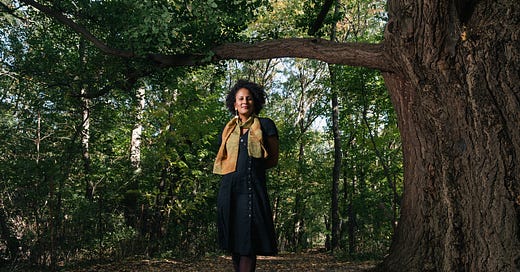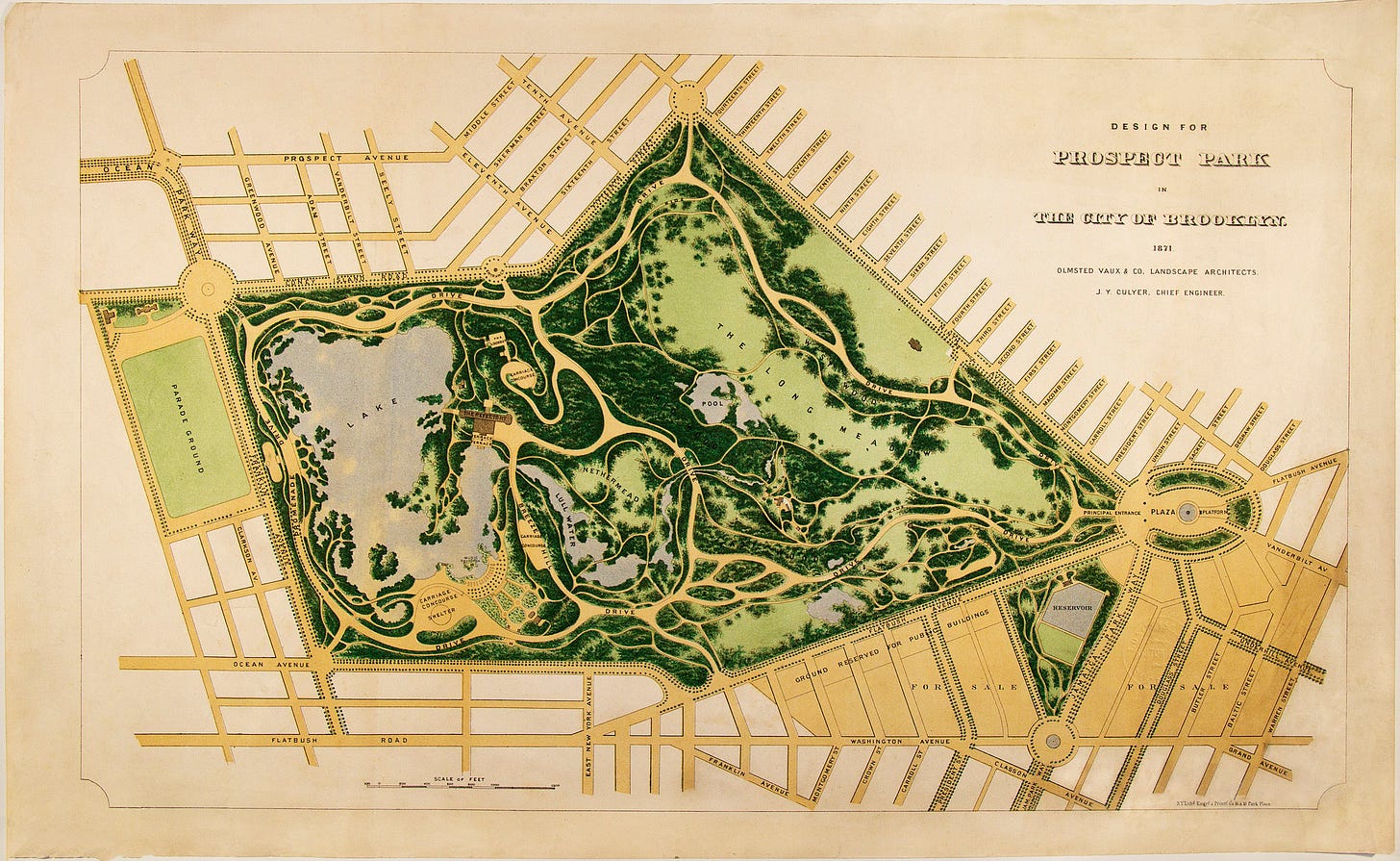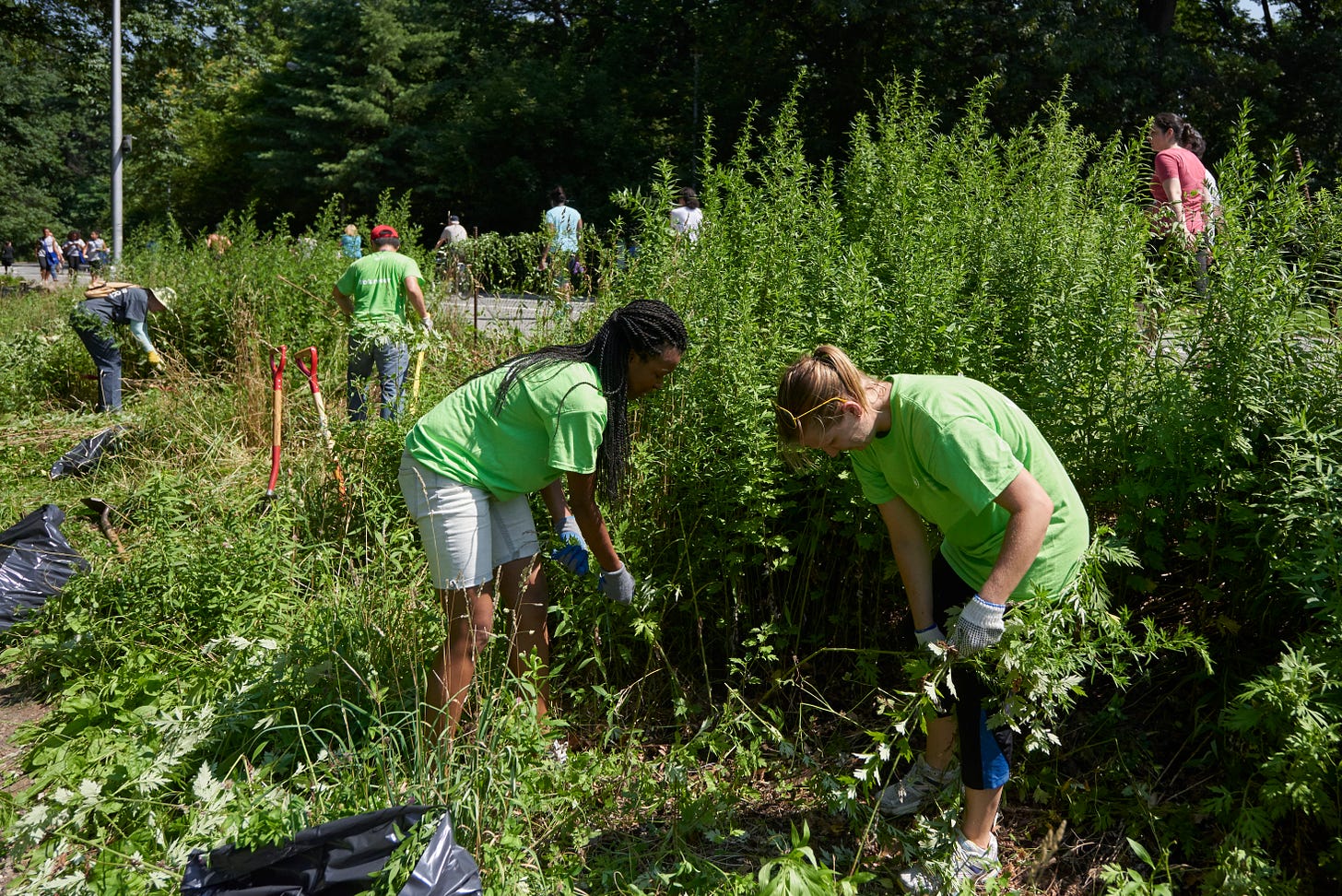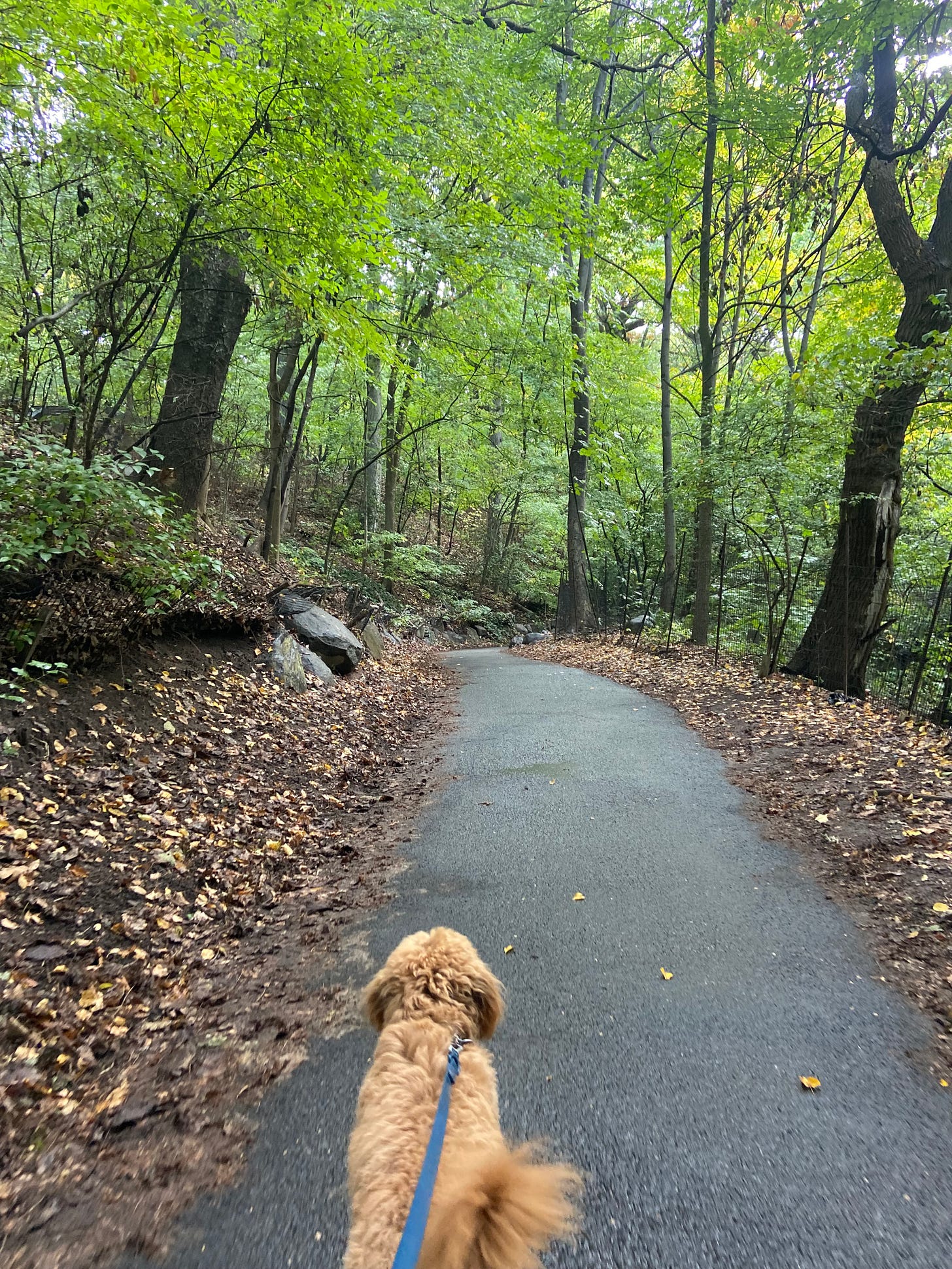Parks Role in Climate Resilient Cities
A look at Brooklyn’s Prospect Park
This post is part of our Optimist In Action series, featuring stories of people, companies, and organizations working for positive change. The interview and piece were conducted and written by Matthew Gutierrez.
On a recent morning, Morgan Monaco leaned over to glance at an old Brooklyn Prospect Park map. She gave a warm smile at the park that’s become her second home. It’s a familiar sight for Monaco, President of Prospect Park Alliance, the non-profit organization that sustains Brooklyn's Backyard. Monaco got engaged to her husband in the park just a few steps from her office today. She lives in nearby Windsor Terrace.
Monaco notes that Prospect Park was laid out by Frederick Law Olmsted and Calvert Vaux, who also helped design Manhattan's Central Park. The genius in their design lasts all these years later.
“You come into the park from Grand Army (Plaza), and you're literally transformed, you go into a bridge, and you come out on the other side,” she says. “Brooklyn is no longer there. You see these beautiful rolling hills on the long meadow, and you just have this openness in your soul that comes as a result of coming through that bridge.”
Monaco’s description illustrates the escape that beautiful green spaces provide city dwellers. Unfortunately, precious urban green space has dwindled in the U.S. in recent decades. Paved roads, parking lots, and buildings have replaced natural areas. Urban green space competes with the demand for safe, affordable housing in crowded cities. But parks are critical for a healthy, livable city. They aren’t just for family picnics and softball games; they’re a vital part of an ecosystem and key to making cities livable as the climate changes.
Prospect Park has been transformed since the Alliance was formed in 1987 to restore the park. A long slide left it to boarded-up buildings and car traffic. Despite the enormous progress, there’s always more to be done with such a sizable park of 526 acres (Central Park is 843 acres).
Monaco, the first Black leader of the Alliance, knows the challenge of protecting and enhancing the park won’t be easy as the world continues to warm. But she grew up in Manhattan’s Upper West Side, where she fell in love with Central Park and recognized the benefits it provides millions of New Yorkers and tourists. She’s long been familiar with the parks world: In high school and college, she interned for Adrian Benepe, then the Manhattan borough commissioner for the Parks Department.
After college, she worked for the department twice, once as the director of the campaign to plant a million trees.
Backing Monaco’s efforts are the Alliance’s operating budget, which provides more than $13 million a year to care for the park, and its endowment of more than $25 million. The Alliance has also arranged for more than $130 million in public funding for capital improvements in the park. Early this month, Monaco sat with The Climate Optimist at her office in Prospect Park to discuss the role of urban green spaces in cities, how to sustain our precious natural spaces, and the intersection of the environment and health services.
What was your introduction to NYC and Prospect Park?
I was born and raised on the Upper West Side. I was raised by a single mom who found an organization called Early Steps, which provides scholarships for minority students to enter the independent school system. In high school, they required us to have a two-week internship to graduate. That led to my internship in the Parks Department.
I answered phones and did paperwork, but I also went with Adrian Benepe to ribbon cuttings and meetings with council members, and elected officials. That completely transformed my life. I'm sitting here today because I got exposure to the possibility of a career in public service. I never once considered that. I thought I would go work for MTV or something. But I fell in love with service, and every time I would see an NYC parks truck go by with a leaf on it, I had this incredible sense of pride.
Growing up, what was your relationship with the natural world?
Central Park was my second home. My mom literally had to drag me out of the playground every night because it was my happy place. It was really a huge part of my identity. I was the public service bug, went off to Vassar College, and came back every summer. After college, I worked for StoryCorps in the development office and learned the basics of fundraising.
But then I got a call from the Parks Department's chief of staff who said the mayor had launched an environmental sustainability plan called PlaNYC, aimed at trying to address resiliency in the urban context.
One project was the million-tree campaign, an investment in trees, which are incredibly important in stormwater capture, air quality improvement, and climate change.
“It was the most exciting job in the world. I planted trees all the way from the tip of Van Cortlandt Park in the Bronx to conference house Park in Staten Island and everything in between.”
What other experience has brought you here today?
In graduate school, I got more exposure to social justice issues and criminal justice issues in particular. I met a woman who ran a nonprofit that provides transitional employment for people coming out of prison. She brought me to the de Blasio administration as a senior policy advisor at the mayor’s office. Before that, my background had been mostly in open spaces and urban forestry.
But at the mayor’s office, we launched key initiatives related to equity, which was incredibly valuable to my understanding of how to go from idea to action.
Where do you live? What do you enjoy about Prospect Park?
My husband and I live with our four-year-old in Windsor Terrace. We got engaged at the park, and we met when we both worked for the Parks Department. I can walk or bike to work. On my way home, I look at the conditions, I’m seeing who's out there and just sort of different ways people are using the park.
How can people best support urban parks?
Everything from recognizing the role you play the second you step into the park and being mindful of trash. If you have the time and capacity to volunteer, we welcome that.
How has the park evolved?
In the late 1980s, there were cars in the park, and there was a complete disregard for the park as a place where plants and animals live. It was not considered the incredible essential part of urban life that we consider it now.
Over the past three decades, we've slowly renovated almost all areas of the park. We were founded by a wonderful woman named Tupper Thomas, whose vision was to improve the park. I think Tupper realized this is Brooklyn's only remaining forest, and we’ve got to make sure that we are the stewards of this forest. (The park has 30,000 trees of more than 175 species!)
What is your primary focus now?
Restoring and renovating. One project: Our park has an active relationship with birds and insects from Greenwood Cemetery. We want to make sure that there's this kind of migratory pattern from Greenwood to the park. We want to ensure we're creating the best possible habitat for migratory birds and insects.
What’s another project that excites you?
We have a historic farm homestead, the Lefferts Historic House on the east side of the park that I'm really excited about. It’s a museum serving children and families, but currently, it’s from the perspective of the colonizer of the land: the Lefferts family. We received a prestigious Mellon Grant to reimagine our interpretation of the house from the perspective of the people whose lands were stolen.
Enslaved Africans farmed that land. Many people don’t think there was slavery in Brooklyn, but there was, and we have hired a historian to find the names of the enslaved Africans using census data. It’s a wonderful community research project, and volunteers are parsing through dense material because there weren’t great records. Slave owners weren’t incentivized to document any information other than from a financial perspective, right? “I paid X for this person,” and such. We’re building the narratives of what peoples’ lives were like.
Why is that important to you?
That is so important to me, especially as the Alliance's first Black president, to shift this perspective on a narrative that's often overlooked. There's a lot of healing that needs to happen in this country about reconciling slavery and its impact over generations. We're just still in the early stages of acknowledging that. I'm grateful for the small part we can play in that.
It also aligns with my vision for health and healing. There’s symbolism, where the park is a contributor to acknowledging the pain of people who have suffered in this country. It's an incredible honor and privilege to help transform people's experience when they come into the park.
Why is it important to cherish green spaces, particularly in urban areas?
The park is a landscape for health and healing. Studies show you can decrease your blood pressure by being here.
“When you look at trees, specifically leaves, moving in the wind, that has a calming effect.”
You go to a BBQ, your kid’s birthday, and you find joy in an urban environment. Since the pandemic and George Floyd's murder, there’s been a call to action to address systemic racism in our country, as well as the climate crisis. Being in the park helps to find respite from that experience.
What other roles do you see parks having in our lives?
We are an essential part of Brooklyn life. I feel I have the luckiest job in the world because I get to be a part of such an incredibly important part of what it means to live in New York City. Every single person I talk to has some kind of emotional connection to the park.
It's where they go for their daily run, where they meditate, where they have their barbecue. And that is so incredibly valuable. And I feel lucky to be here because I'm in the business of joy and happiness, right? I get to be the steward of this really sacred place where people have such a strong connection, and that's only increased over the past three years with the pandemic.
You alluded to this earlier: What can you share about the connection between green spaces and public health services?
Since the pandemic, we understand there's unaddressed trauma as a result of the pandemic and a mental health crisis in our country. People are starting to understand the depth of mental health needs in our society, particularly some of the most vulnerable. I would love to explore the ways in which the park can address that.
We can be the landscape to host events and programs oriented toward mental health: meditation, yoga, silent walks, and tents where people can sign up for health insurance. Then there’s mobile treatment: vaccine buses and vans. We could easily accommodate services in mobile vans in the park. People can come to the park for healing.
What’s the park’s top connection to climate change? Is it trees, the open fields?
Our commitment to combating climate change really has to do with our forests. And our natural areas. Some volunteers are trained in invasive species identification and know how to use tools to restore our forest. It’s one of our city's best assets to mitigate the impact of climate change.
What gives you hope for the future of Prospect Park, green spaces like it in general focus on Prospect Park. What makes you a climate optimist?
What gives me hope is the incredible benefit I've received from being a part of parks and open spaces. And I’m inspired talking to New Yorkers who come to the park, you see the benefit has on them. This park is so beloved by our community.
I believe in the power of local residents caring about their community and doing something about it. That's how, 36 years later, we exist.
And it gives me hope that New Yorkers are inherently good and want to do good. Never doubt that a small group of people have the ability to change the world. In fact, it's the only thing that ever has. Margaret Mead said that.










